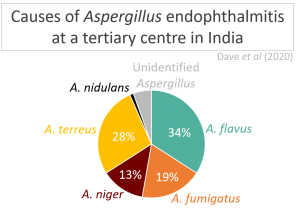Submitted by Aspergillus Administrator on 23 August 2010
This fierce debate has raged for some years now and shows few signs of abating, but as both sides of the argument have much to lose that isn’t too much of a surprise.
Recent events in Africa have illustrated the dreadful consequences of mycotoxin getting into food, but these levels are far more strictly controlled in the developed parts of the world such as EU & USA, not least because food storage conditions are much better controlled.
The home & work environment is a different matter. Major floods cause massive damage to property and leave what is left standing very wet & mouldy. The occupants often have no choice but to carry on living in their damaged houses and thus are forced to breathe in air inevitably charged with mould spores.
There are of course many more buildings that become contaminated by moulds without the need for huge natural disasters – a simple unattended pipe leak can cause the growth of a lot of mould in a few days. Moulds need no light to grow (are in fact inhibited by light) so there are many examples of moulds growing in closed appliances such as air conditioning units and consequently causing lots of mould spores to be released into the air.
The difficulty lies in assessing whether or not the spores being breathed in are causing health problems. One part of the debate is fairly clear – the breathing in of mould spores can trigger allergies and can do it over a very long time if the source of the mould remains undetected. These allergies can trigger more serious health problems such as asthma, particularly amongst children – damp, mouldy homes are proven to be bad for our health.
What about mycotoxin toxicity? Toxins cause problems to health depending on how much enters the body of the victim i.e. toxicity is dose dependant. A fair amount is known about what dose causes health problems when food is contaminated, but this is generally based on acute outbreaks of mycotoxicity when people or animals eat heavily contaminated food for a relatively short time. The people at risk often have no other food to eat so do tend to get high doses.
What is a safe amount to eat, given that even in the developed world it is virtually impossible to totally eliminate mycotoxins from our diet? (Some enlightening UK figures here).
The various national and international authorities set ‘safe limits’ for food and animal feed based on individual toxin levels.
Small amounts are thought to have minimal effect as they are usually quickly removed by our livers (all of us will be being exposed to low or very low levels of toxins in our food), but what about continued chronic inhalation of low amounts of several different types of toxin every day- a scenario that is quite likely in a damp building?
The debate comes down to the accumulation of toxins in tissues. Much has been written about what dose a person living in a building would get by breathing in spores, rudimentary calculations have been done on the number of spores they need to inhale and how likely it would be that they could inhale that amount under reasonable circumstances but little of the resulting data is robust. Perhaps it is better to measure the amount of mycotoxin in the different tissues of each person exposed and thus get a direct idea of the level of their exposure? That is exactly what the researchers in this paper have set out to do.
Hooper et.al. have demonstrated that is it possible to detect several different mycotoxins in samples taken from patients known to have been exposed to mould (though they don’t say what their criteria for this were) and to determine the amount of each mycotoxin in each sample. The techniques are simple adaptions of current technology so should be widely applicable. The amounts measured are correlated with reported clinical signs of illness, though most seem to be quite vague..
Amounts measured for each mycotoxin (trichothecenes, aflatoxins, and ochratoxins) tested in urine in this paper seem to be of the order of 0.2 to >2 parts per billlion which equates to 0.2 to >2 microgrammes per litre. Assuming a litre of urine produced per person per day that could be 0.2 to >2 microgrammes per day.
If we look at ochratoxin levels in the urine of normal healthy people in this paper we find up to 0.025 microgramme per litre per day – ten to a hundred fold less than that in people exposed to mould in the previous paper.
If this study is borne out we now seem to have some of the tools needed to directly measure exposure to mycotoxins in the body tissues of people exposed to moulds in their environment. Further studies will be needed to determine the effects of that exposure on human health and what factors in low level chronic exposure are important – e.g. current dose, total cumulative dose, length of exposure, which mycotoxin or combination of mycotoxins has worst effects.
News archives
-
Title
Date



